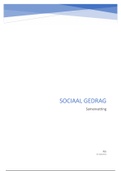Summary
PYC2602 SUMMARY Child & Adolescent Development 2020/02
- Institution
- University Of South Africa (Unisa)
A comprehensive summary of the work contained in the Prescribed Book and Study Material, incl. a full list of definitions, figures, graphs and pictures to aid the learning experience.
[Show more]





